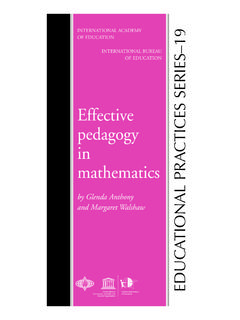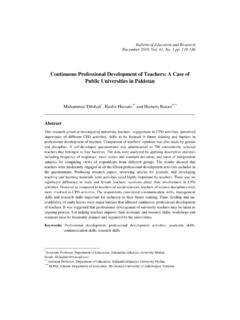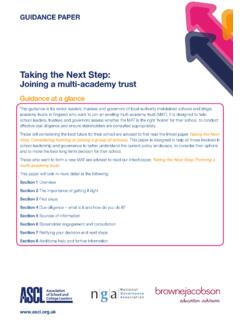Transcription of Materials Evaluation and Development: Syllabus, Setting ...
1 ISSN 2336-2022 International Journal of Teaching and Education Vol. II (No. 2). Materials Evaluation and development : syllabus , Setting and Learner Needs rfan SARI*, Serkan LG **, S leyman NAL**. *Turkish Air Force academy , **Turkish Air Force academy , **Turkish Air Force academy , Abstract The present paper draws insights to teacher and learners in terms of material development . Teaching of a language (foreign or second) has been an important issue in today's world. Also it is not only an area of teaching but also an area of economic concerns. As a natural outcome that brings out there is a hard competition among the publishers to obtain the high quality of the Materials . Any language learning process traditionally needs print Materials or non-print Materials (Reinders and White, 2010; Richards, 2001, p. 251;. McGrath, 2002, pp.)
2 125-136). Having reviewed related literature on Materials Evaluation and development , it is clear that not only one should get benefit from a wide variety of resources but one should consider many dimensions of Evaluation to reach the ultimate aim of teaching- learning process. It should also be in mind that today's evaluations and Materials will not be sufficient for tomorrow's Setting . Key words: Materials Evaluation and development , syllabus , learner needs 60. ISSN 2336-2022 International Journal of Teaching and Education Vol. II (No. 2). Introduction There is a vast literature on Materials Evaluation and development therefore it will be briefly mentioned especially in terms of Setting , syllabus and learner needs. Any language learning process traditionally needs print Materials or non-print Materials (Reinders and White, 2010; Richards, 2001, p.
3 251; McGrath, 2002, pp. 125-136). According to Tomlinson (1998) Materials are considered anything which is used to help language learning. Examples include but are not limited to: coursebooks, workbooks, CDs, flashcards, and CD-ROMs. These Materials need to be looked at within a given context and a syllabus derived from a specific approach (McDonough and Shaw, 2003, pp. 4-14). According to Tomlinson (2008, pp. 3-4, 2010, p. 83), successful Materials development should be envisaged as learning Materials and the principles to follow need to show the central role that learners should play. While Materials Evaluation is considered a procedure that involves examining learning Materials to establish their value, Materials development refers to anything which is done by writer, teachers or learners to provide sources of language input (Tomlinson, 1998, ).
4 material Evaluation is a dynamic process which is "fundamentally a subjective, rule-of-thumb activity" where "no neat formula, grid, or system will ever provide a definitive yardstick" (Sheldon, 1988, p. 245). Sheldon argues that the criteria and the key questions central for Setting up a material Evaluation scheme partly depends on "the swings of linguistic fashion" (p. 240). Rod Ellis (1997) differentiates between two types of Materials Evaluation : a predictive Evaluation and a retrospective Evaluation . A predictive Evaluation is designed to make a decision regarding what Materials to use, whereas a retrospective Evaluation designed to examine Materials that have actually been used. A brief review of the literature relating to Materials Evaluation reveals that the research focus to date has been more or less exclusively on predictive Evaluation .
5 Retrospective Evaluation provides teachers with information regarding the strengths and weaknesses of the used syllabus . It also serves "as a means of testing the validity of a predictive Evaluation , and may point to ways in which the predictive instruments can be improved for future use" (Ellis, 1997, p. 37). Rea-Dickens (1994, cited in Li, 2004) summarizes three kinds of Evaluation : (1) pre-use Evaluation ;. (2) in-use Evaluation ; and (3) post-use Evaluation , measured in terms of learners'. performance. She advocates giving more attention to in-use and post-use Evaluation . Evaluations can be carried out pre-use, in-use or post-use. The main aim of evaluating Materials pre-use, according to Rubdy (2003, p. 42), is to measure the potential of what teachers and learners can do with them in the classroom. In-use and post-use evaluations are important in establishing how successful learning Materials are (McDonough & Shaw, 2003, p.)
6 71). Skierso (1991) suggests a different framework explaining that the first step of material Evaluation is to collect information about students' background, the course syllabus , and the learning context. Skierso then divides Materials into five subsections: bibliographical data, aims and goals, subject matter, vocabulary and structures, and layout and physical makeup. Cunningsworth (1995), Harmer (1991, 1998), Roberts (1996), Ur (1996), Brown (1997), Hemsley (1997), McGrath (2002) and Gearing (1999) also proposed checklists for evaluating Materials . 61. ISSN 2336-2022 International Journal of Teaching and Education Vol. II (No. 2). Setting Setting is one of the key elements that provide basics of teaching Materials . Although there is limited information on the relationship of Setting and Materials , McDonough and Shaw (1993) stated some criteria that influence selection of course Materials .
7 The role of English in the country, the role of English in the school, the teachers, management and administration, resources available, support personnel, the number of pupils, time available for the program, physical environment, the socio-cultural environment, the types of tests used, and ways in which students are evaluated, procedures for monitoring and evaluating the language teaching and so on. syllabus Curriculum is used as a general term for the entire organized teaching plan of a subject. syllabus refers to a pre-defined teacher and supervisor definition of how the curriculum will be accomplished over a predefined period. A curriculum can consist of a number of syllabi (Ullmann, 1982). In many parts of the world, language education programs are designed following a syllabus -driven approach, that is, the syllabus determines what kind of Materials will be adopted and in what ways they will be exploited for the classroom teaching.
8 In certain educational contexts, the syllabus even determines how Materials should be designed in the first place. material Evaluation consists of establishing criteria for the curriculum and its match to the syllabus . Listed below are the syllabuses to be considered in the process of Evaluation ;. Grammatical syllabuses: The syllabus input is selected and graded according to grammatical notions of simplicity and complexity. These syllabuses introduce one item at a time and require mastery of that item before moving on to the next. Lexical syllabuses: Lexical syllabuses identify a target vocabulary to be taught normally arranged according to levels such as the first 500, 1000, 1500, 2000 words. Skills syllabuses: Skills syllabuses are organized around the different underlying abilities that are involved in using a language for purposes such as reading, writing, listening, or speaking.
9 Functional-notional syllabuses: In functional-notional syllabuses, the input is selected and graded according to the communicative functions (such as requesting, complaining, suggesting, and agreeing) that language learners need to perform at the end of the language program. Content syllabuses: In content syllabuses, the content of language learning might be defined in terms of situations, topics, themes, or other academic or school subjects. Task-based syllabuses: Task-based syllabuses are more concerned with the classroom processes which stimulate learning. These syllabuses consist of a list of specification of the tasks and activities that the learners will engage in class in the target language (Pakkan, 1997; Brown, 1995; Harmer, 2001). 62. ISSN 2336-2022 International Journal of Teaching and Education Vol.
10 II (No. 2). Learner Needs While Evaluation and developing Materials it is impossible not to mention about the needs and variables of learners as the Materials for learners' use. Yorio (1976, cited in Brown, 2000, p. 273) classified learner variables as; age, cognition, native language, input, affective domain and education background. Griffiths (2008) also lists a variety of variables such as;. Maturational factors: Critical/sensitive period, myelination, Socio-affective factors: Culture/language shock, Social distance, anxiety, identity, disorientation, status, Cognitive factors: Existing knowledge, strategic awareness, understanding of rule systems, metacognitive control, Individual factors: Aptitude, attitude, gender, culture, personality, motivation, style, beliefs, prior learning, autonomy, personal circumstances, Situational factors: Naturalistic, distance learning, classroom, daytime/night-time, teaching/learning, method, learning target, In her learner variables study Griffiths (2008, ) visualized the preferred learning methods of the learners (Table 1).







